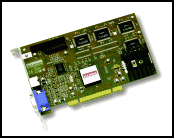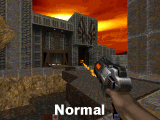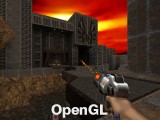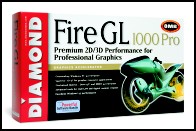


"We did find some welcome surprises, such as unrivaled MPEG playback quality."

Diamond FireGL 1000 Pro 8mb PCI
![]()
 The physical board itself looks quite impressive with two large heatsinks that never got above "warm" during testing. The FireGL features a flash BIOS, but video in and out ports are sadly missing. The software bundle is quite skimpy, including little above and beyond the prerequisite drivers for Windows 95 and NT 4.0. Drivers for NT 3.5, Windows 3.1 and OS/2 aren�t provided, so users running these operating systems will have to look to Elsa for a video solution. Anyone with high-resolution DOS software will be saddened to hear that no DOS VESA support is provided, nor expected in the future.
The physical board itself looks quite impressive with two large heatsinks that never got above "warm" during testing. The FireGL features a flash BIOS, but video in and out ports are sadly missing. The software bundle is quite skimpy, including little above and beyond the prerequisite drivers for Windows 95 and NT 4.0. Drivers for NT 3.5, Windows 3.1 and OS/2 aren�t provided, so users running these operating systems will have to look to Elsa for a video solution. Anyone with high-resolution DOS software will be saddened to hear that no DOS VESA support is provided, nor expected in the future.
As with the other review boards, we had no difficulties installing the FireGL in Windows 95. We were pleased to see that the image it produced was a fair bit brighter than the Elsa Permedia2 board, while still being as sharp. Diamond�s drivers were remarkably plain and provided absolutely no extended controls such as fine screen positioning, sizing and custom refresh rates. We found this surprising considering that this board is targeted towards professional users. While Diamond advertises OpenGL acceleration - and provides it - it was extremely slow in Windows 95 providing only 16fps at 640x480 in Quake II. While future drivers may improve on this, we feel this board is more suited to the business world of Windows NT than the consumer world of Windows 95.
|
| ||

 Click each image for a larger version. |
||
|
| ||
2D performance was strangely lacking, falling a fair bit behind the Riva128 boards and even Elsa�s board in both 16 and 32-bit. A subpar Winstone 98 score in true color of 14.6 was bested by both the Riva128 boards and our other Permedia2 board. It�s 230Mhz RAMDAC allows for up to 100Hz at 1280x1024 16-bit.
3D performance was better with a respectable WinMark score of 266. Jedi Knight played flawlessly and came away with adequate scores of 35 frames per second at 640x480 and 28fps at 800x600.
 We did find some welcome surprises, such as unrivaled MPEG playback quality. The FireGL produced the best median between pixel smoothing and edge enhancing with exceptionally smooth playback up to 1024x768 true color full screen.
We did find some welcome surprises, such as unrivaled MPEG playback quality. The FireGL produced the best median between pixel smoothing and edge enhancing with exceptionally smooth playback up to 1024x768 true color full screen.
The FireGL Pro 1000 proved to have excellent video quality, while also being one of the few new boards to offer both OpenGL acceleration and 8mb RAM. We recommend it to professionals running Windows NT, but advise home users to look elsewhere.
|
| ||
|
COMPANY: Diamond Multimedia PRODUCT: FireGL 1000 Pro 8mb SGRAM PCI WEB SITE: www.diamondmm.com PHONE: 1-800-4-MULTIMEDIA |
||
|
| ||
|
Benchmarks
|
||
|
| ||
![]() © 1998 Sunstorm Systems
© 1998 Sunstorm Systems